The landscape of the ecommerce industry is witnessing a surge in competitiveness. Projections indicate that by the close of 2024, online transactions will account for one out of every five retail sales. As a business proprietor, the imperative goals revolve around surpassing competitors and establishing market dominance. The key to achieving this lies in conducting a comprehensive ecommerce competitive analysis.
Through a meticulous examination of your nearest competitors, their strategic positioning, and overarching business methodologies, you can adeptly fortify and sustain your foothold in the dynamic ecommerce market. This strategic insight equips you with the tools to navigate the competitive terrain and strategically position your business for success.
Why is Ecommerce Competitor Analysis Crucial?
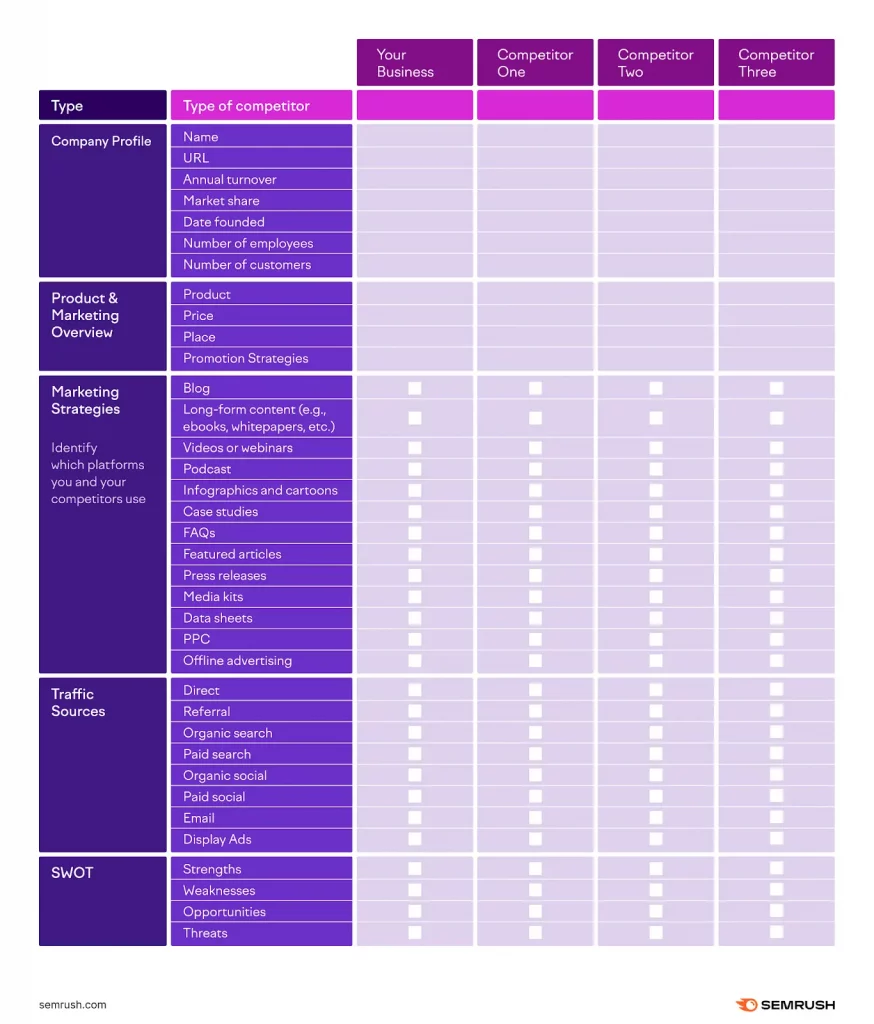
Competitor analysis serves as the catalyst for achieving triumph in the realm of ecommerce. Through a comprehensive evaluation of competitors’ strengths, weaknesses, and strategies, businesses can strategically position themselves, navigate market dynamics, and make well-informed decisions, ultimately maximizing growth and profitability.
- Unveiling Business Strengths and Weaknesses: Ecommerce competitive analysis serves as a reflective mirror, unveiling the distinctive strengths and weaknesses of your business. Recognizing your company’s strengths is pivotal for establishing a robust market position. By effectively conveying the superior benefits of your goods or services compared to competitors, you can win customer allegiance and foster loyalty.
- Understanding the Market and Identifying Gaps: Imagine a bustling marketplace where you aim to sell your product. To outshine the competition, market understanding is key. Competitor analysis provides the opportunity to eavesdrop on your competitors’ conversations with customers. Furthermore, analyzing competitors’ offerings helps identify underserved areas in the market. Seizing these opportunities allows for expanding your offerings, meeting customer needs, and propelling business growth.
- Navigating Industry Trends: Identifying ecommerce trends is akin to gazing into a crystal ball that offers insights into the future of an entire sector. It empowers you to anticipate changes in consumer habits, market shifts, and emerging business models. Armed with this foresight, you can stay ahead of the competition, explore new avenues, and establish yourself as an innovator and industry leader.
- Setting Future Growth Goals: When conducting a competitor analysis, it’s crucial not to focus solely on larger companies. Broaden your perspective by also examining smaller players. Researching new entrants into your industry provides insights into potential threats that may impact your market share in the future. This comprehensive approach allows you to set strategic growth goals that account for a diverse competitive landscape.
How to Conduct an Ecommerce Competitive Analysis: A Step-by-Step Guide
Undertaking a competitor analysis for your ecommerce store involves a systematic approach to gather vital information and insights about your competitors. Here’s a comprehensive guideline on how to conduct a thorough competitor analysis:
1. Access Essential Tools and Websites:

To perform comprehensive research on your ecommerce competitors, you need key resources such as software and websites. Here are some crucial ones:
- Google: Utilize Google for in-depth information. Conduct keyword searches to discover relevant data and insights about your competitors.
- Social Media: Social media platforms are a new standard for advertising. Understand the intricacies of various platforms for effective competitor research.
- YouTube: YouTube is a critical platform for competitor analysis, providing unique insights into how competitors visually present their products.
- Indeed or Similar Job Sites: Unexpectedly valuable, job sites like Indeed or LinkedIn can offer insights into competitors’ recruiting practices through job ads.
- Quora: Quora serves as a great platform to learn about new goods, trends, and discover potential competitors. Specific questions can yield a wealth of data and insights.
- Marketing Research Tools: Leverage marketing research tools for a deeper understanding of your target audience and competitors. These tools offer capabilities such as market segmentation analysis, web change audits, competitor benchmarking, keyword analysis, and social media monitoring. They provide businesses with valuable intelligence for refining services and optimizing campaigns, giving them a crucial edge over competitors.
2. Define Your Ecommerce Business and Goals
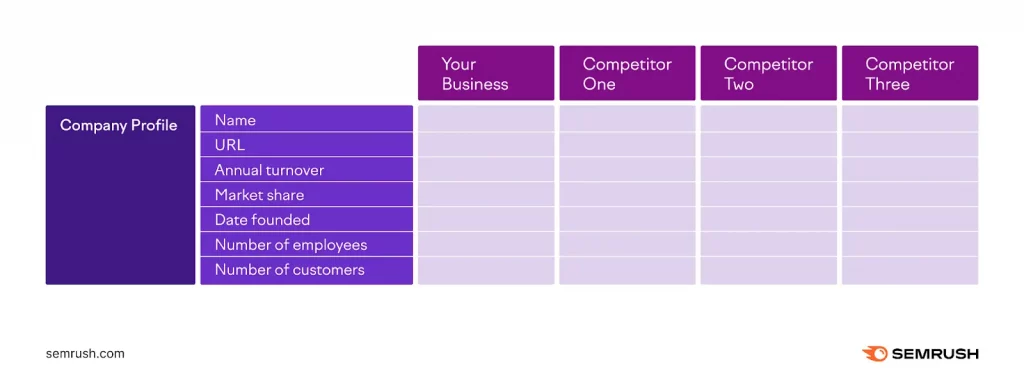
Keep in mind that amassing a wealth of information about your competition becomes futile if you lack a deep understanding of your own company and the desires of your consumers. image of define your ecommerce business and goalsSource: Unsplash
To solidify the focus of your ecommerce company, consider the following questions:
- Are you inclined to be an innovator, a follower, or a challenger in the market?
- What is the duration of your experience in the field – are you a seasoned player or just starting out?
- What are the precise objectives you aim to achieve, and who constitutes your targeted clientele?
Once you have a clear understanding of your ecommerce setup, the subsequent step involves defining the goals you intend to fulfill through the competitive analysis:
- Are you seeking to refine your unique selling proposition?
- Do you aspire to enhance your branding techniques?
- Is increasing your social media following a priority?
- Are you looking to augment your existing conversion rates?
3. Identify Your Business Competitors
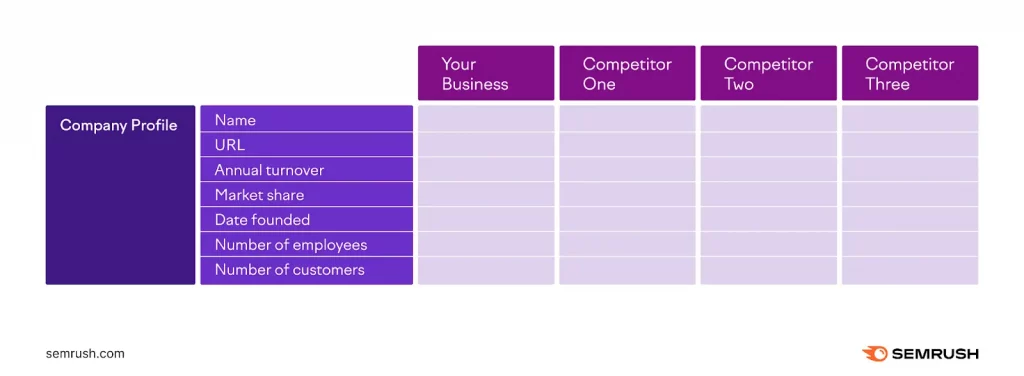
Now that you have a clear understanding of your company’s goals, the next step is to pinpoint your competitors.
You can accomplish this by entering your product name or category into a search engine, such as Google, and examining the results. Alternatively, you can gather insights from your existing customers by inquiring about the alternatives they considered before selecting your product or service.
Once you’ve generated a list of potential competitors, ensure it encompasses a diverse range of companies. Consider including businesses that fall into these categories:
- Direct Competitors: Those that offer the same products or services as your business.
- Indirect Competitors: Those providing similar products or services but not directly competing.
- Substitute Competitors: Competitors offering a different solution to the same problem.
4. Create a Comprehensive Competitor Matrix for Ecommerce Competitive Analysis
In the realm of ecommerce competitive analysis, meticulous organization becomes a powerful asset. Enter the competitor matrix – a strategic tool designed to consolidate and compare research findings effectively.
Picture the competitor matrix as your centralized hub where intricate details about your competitors converge in a unified table or spreadsheet.
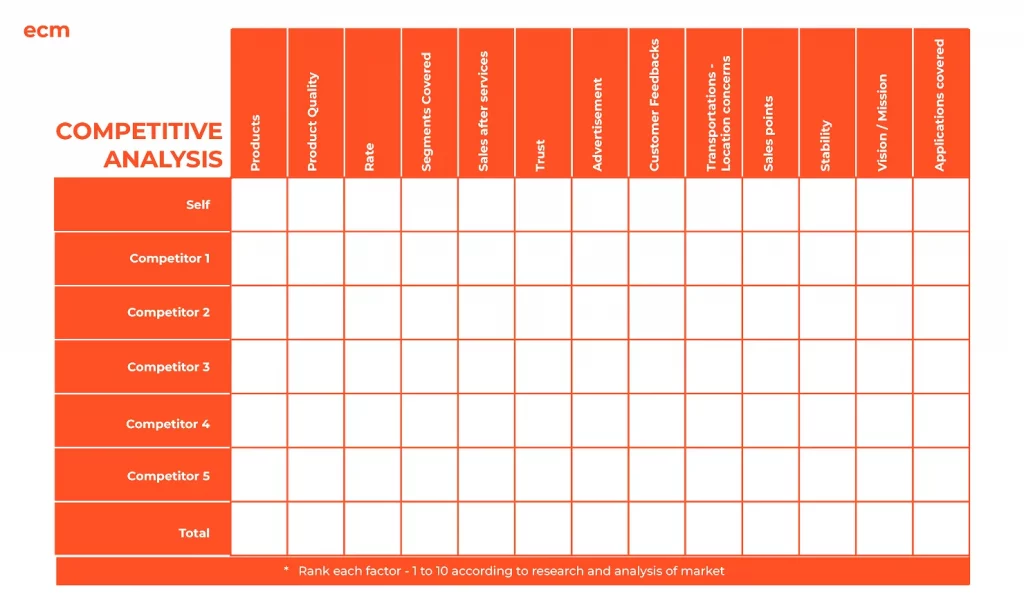
Here’s how to approach it: Dedicate a cell in the table to each competitor, providing a magnified view of their strategies and maneuvers. On the opposite axis, list down the variables or categories of interest.
This matrix serves as a reservoir of intelligence, offering insights into various aspects, ranging from their product line and pricing structures to marketing techniques. It provides a comprehensive overview, enabling you to analyze and decipher crucial information about your competitors.
Learn about competitior SEO tools here.
5. Evaluate Brand Positioning Strategies in Detail
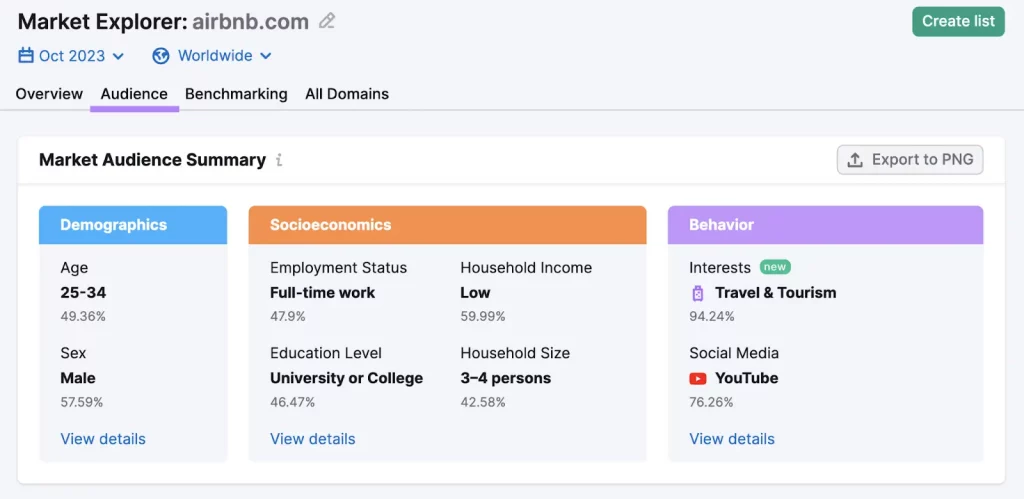
Source: Semrush
In-depth analysis of your competitors’ brand positioning and marketing strategies involves delving into the content they disseminate across various channels—be it blogs, website sliders, PR releases, or sponsored advertisements.
By scrutinizing their communications, you can gain valuable insights into the following aspects:
- Keyword Emphasis: Identify the keywords your competitors prioritize, offering insights into their focal points and areas of expertise.
- Customer Attraction Tactics: Understand how competitors entice new clients. Is it through competitive pricing, superior products, or an enhanced overall customer experience?
- Points of Differentiation: Determine the unique attributes that set your brand apart from the competition.
- Concise Competitor Descriptions: Distill the essence of each competitor into a single, impactful statement. This exercise aids in summarizing the distinctive features and market positions of each competitor.
6. Profiling Competitors’ Target Customers
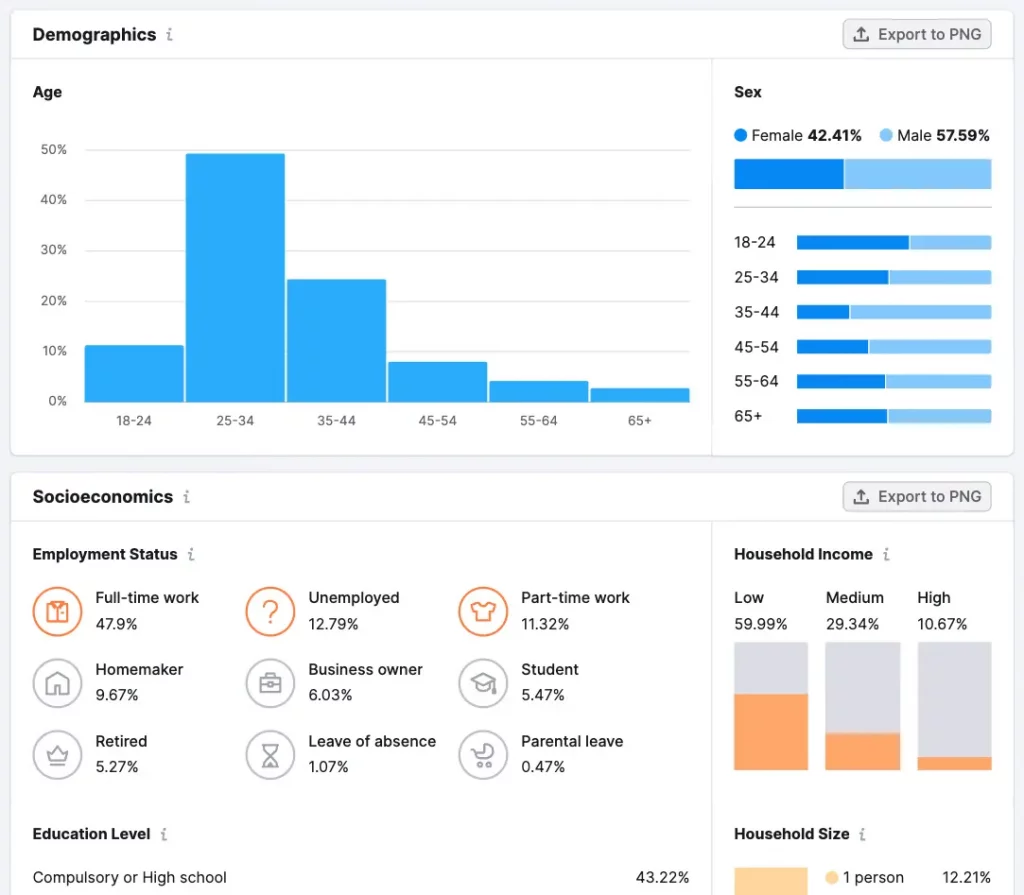
Understanding the target customers of your competitors is a pivotal aspect of gaining strategic insights into their business strategies. To unveil the intended audience, employ the following tactical approaches:
- Mission Statement Analysis: Delve into your competitors’ mission statements, extracting nuanced information that provides clarity on their aimed audience.
- Messaging Decryption: Scrutinize the language and tone in their communications to discern the demographic they are targeting.
- Social Media Observations: Conduct a thorough analysis of their social media interactions. Insights garnered from these platforms can unveil crucial details about their target audience.
- Customer Showcases: Observe if they prominently feature existing customers in their content. This can serve as a revealing indicator of their target customer profile.
7. In-Depth Exploration of Competitors’ Products and Pricing
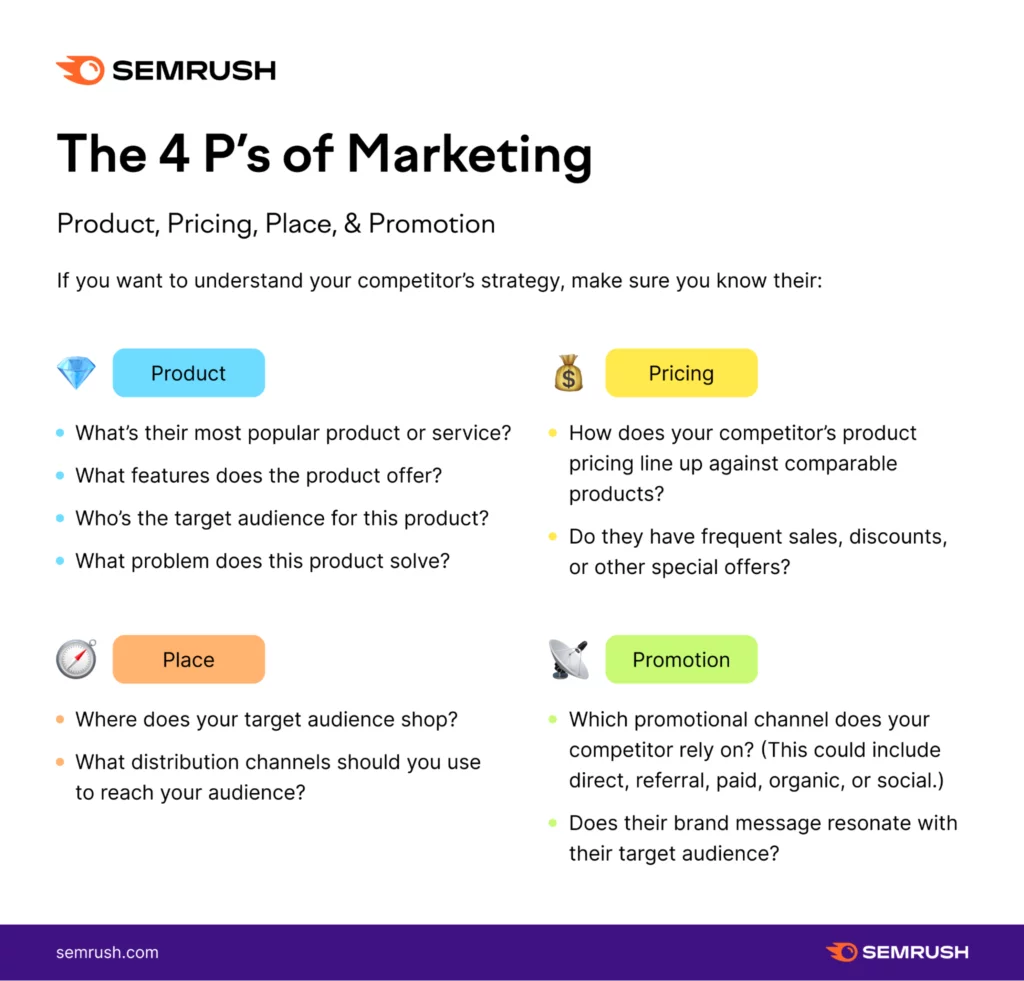
To stay ahead of the competition, a thorough examination of your rivals’ products and pricing strategies is imperative. Here are key insights to consider as you delve into the captivating realm of researching competitors’ offerings:
- Explore Diversified Channels: Venture into various channels to unravel comprehensive details about your competitors’ product lineup. Scrutinize their online stores, explore markets, and delve into their social media pages to gain a holistic perspective.
- Decipher Features and Specifications: Pay meticulous attention to the features, specifications, and unique selling points of their products. This scrutiny unveils how they position themselves in the market and the specific audience they target.
- Unravel the Pricing Puzzle: Analyze their pricing strategies with acumen. Take note of base prices, discounts, promotions, and any fluctuations in pricing over time. Identify patterns and trends that can illuminate their competitive advantages or unveil opportunities for differentiation.
- Identify Added Value: Consider any value-added services or enticing product bundles your competitors provide to attract customers. These insights are invaluable when crafting your own marketing and sales strategies.

8. Scrutinize Competitors’ Advertising and Social Media Tactics
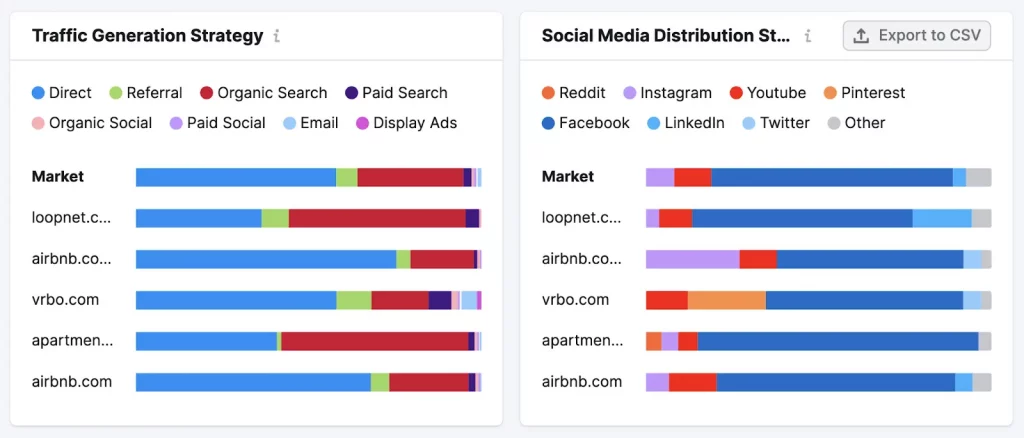
A pivotal aspect of comprehensive competitive analysis involves dissecting how competitors promote their businesses. By delving into their marketing strategies and customer engagement methodologies, you can extract valuable insights into their overall approach. Here’s a guide on gathering pertinent information about their promotional endeavors:
Advertising Analysis:
To gain a competitive edge, it’s crucial to analyze competitors’ advertising campaigns across diverse channels, including print, digital, and television. Thoroughly scrutinizing their messaging, visuals, and target audience allows you to discern their unique selling propositions and the emotions they aim to evoke. This analysis serves as a wellspring of inspiration for your own campaigns, aids in identifying market gaps, and refines your messaging to carve out a distinctive brand identity.
Social Media Presence:
A keen understanding of your competitors’ social media presence is paramount for strategic advantage. Social media platforms offer a window into how competitors engage with their online followers. To accomplish this, scrutinize the content of their posts, frequency of posting, and the level of engagement generated. Explore their social media tactics, influencer collaborations, and user-generated content, including reviews, to unravel the narrative they are crafting around their brand.
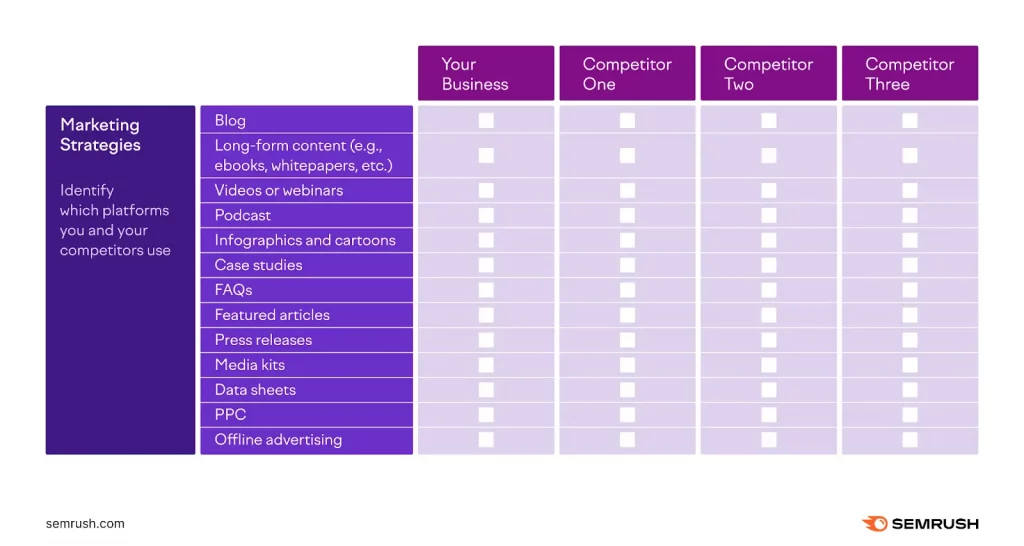
9. Perform a Comprehensive SWOT Analysis on Your Competitors
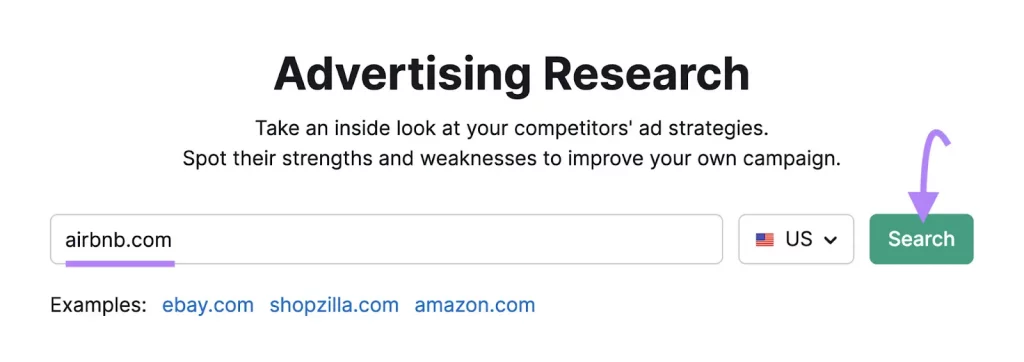
After accumulating insights into your competitors, a critical step involves conducting a SWOT analysis for each of them. SWOT, an acronym for strengths, weaknesses, opportunities, and threats, serves as a powerful tool to evaluate your competitors’ market positions. Here’s a breakdown of each element and its significance:
Strengths: Identify the areas where your competitors excel or what sets them apart as formidable players. Understanding their strengths enables you to strategize ways to surpass them and maintain a competitive edge in the market.
Weaknesses: Pinpoint the areas where your competitors face challenges or exhibit vulnerabilities. Recognizing their weaknesses presents opportunities for you to capitalize on and leverage against them, enhancing your own market standing.
Opportunities: Explore potential growth avenues that your competitors are actively pursuing. Understanding the opportunities they are leveraging can inspire you to uncover similar pathways for growth within your own business, fostering innovation and expansion.
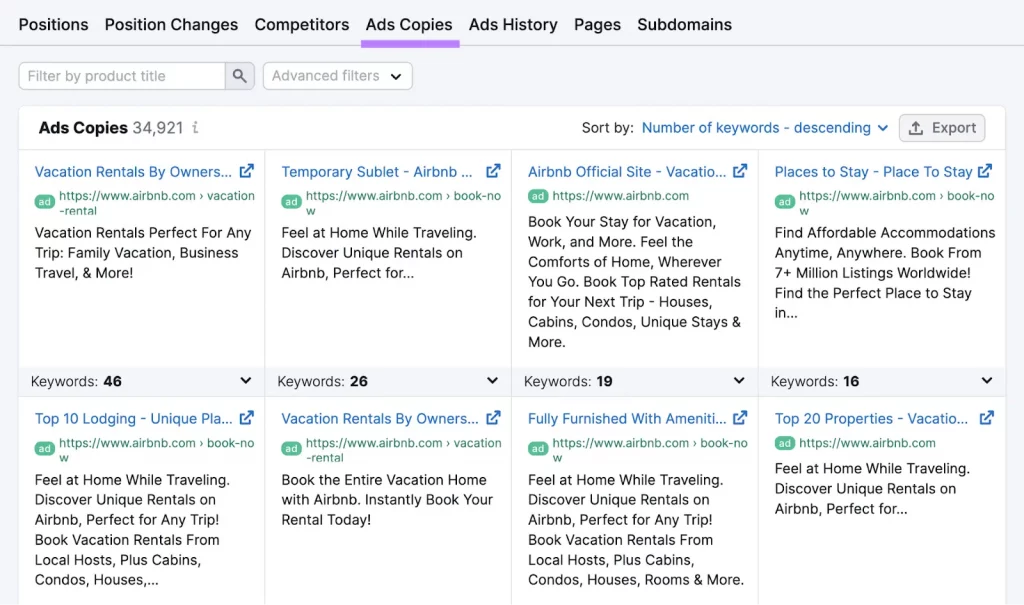
Threats: Consider external factors that pose challenges to your competitors. These could range from the entry of new competitors into the market to supply chain disruptions or evolving consumer preferences. Recognizing the threats they face provides insights into potential challenges you may encounter and guides your strategic planning.
10. Develop a Robust Competitor Analysis Framework

To make sense of the wealth of information gathered about your competitors, implementing a Competitor Analysis framework can prove instrumental.
A well-designed framework allows for the organized presentation of findings, providing a structured approach to comprehending the competitive landscape. This not only enhances your understanding of market dynamics but also equips you with a strategic advantage, fostering smarter business decisions and overall improved company performance.
Unlocking Insights: The Diverse Beneficiaries of Ecommerce Competitive Analysis
1. Business Owners and Entrepreneurs:
- Deeper Industry Insights: Gain a profound understanding of the industry landscape.
- Competitor Identification: Identify key competitors and study their strategies.
- Strategic Differentiation: Pinpoint opportunities to differentiate and position the business effectively.
2. Marketing Professionals:
- Audience Understanding: Learn more about target audiences and evolving market trends.
- Plan Refinement: Improve marketing plans and enhance the effectiveness of campaigns.
- Engagement Enhancement: Fill gaps in coverage, ensuring more compelling consumer interactions.
3. Product Managers:
- Market Gap Detection: Identify gaps in the market for products and assess emerging trends.
- Competitor Product Insight: Acquire valuable information on competing products.
- Enhanced Development Plans: Improve product development plans to align with audience needs.
4. Sales Teams:
- Strategic Edge: Obtain a competitive edge through an in-depth understanding of competitors’ strategies.
- Effective Positioning: Position products effectively, address customer concerns, and highlight unique selling points.
5. Startups and New Market Entrants:
- Landscape Understanding: Grasp the competitive landscape for more informed market entry.
- Viability Evaluation: Evaluate market viability for strategic decision-making.
- Effective Market Penetration: Develop strategies for effective market penetration based on comprehensive competitor insights.
Conclusion:
As we move forward, the integration of competitor analysis into broader business strategies remains paramount. The insights garnered not only empower businesses to thrive in the present but also serve as a compass for navigating the uncharted territories of the future. In essence, competitor analysis is not just a tool; it is a mindset that fosters adaptability, resilience, and sustained success in the dynamic world of business.
FAQs on Competitive Analysis:
What are the common challenges in conducting competitor analysis?
Challenges may include obtaining accurate and up-to-date information, interpreting competitor actions correctly, and balancing the need for in-depth analysis with the speed required to respond to market changes.
What role does competitive pricing play in competitor analysis?
Competitive pricing is a critical aspect of competitor analysis. Understanding how competitors price their products or services helps businesses position themselves strategically in the market, whether as a cost leader or by offering premium value.
Can competitor analysis help in crisis management?
Yes, competitor analysis can be valuable during times of crisis. Understanding how competitors respond to similar challenges can provide insights for crisis management strategies, helping businesses navigate difficult situations more effectively.
How do global and local factors impact competitor analysis?
Global and local factors such as economic conditions, cultural differences, and regulatory environments can impact competitor analysis. Businesses need to consider these factors to understand the broader market context and tailor strategies accordingly.



